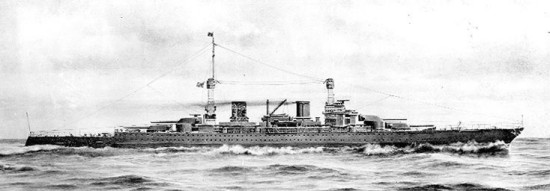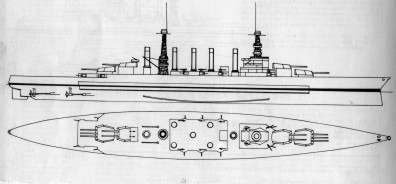

USS Lexington (artist sketch)
SPECIFICATIONS
Displacement: 43,500 tons (normal for final design)
Dimensions: 850 feet length x 105 ft 6 in beam
Guns: Original Design: 12x14 inch (2x3, 2x2); 20x5 inch (20x1)
LEXINGTON CLASS BATTLE CRUISER
| Ship | Laid Down | Suspended | Cancelled | Built By |
| CC-01 Lexington | 08 January 1921 | 02 August 1922 | Redesigned as CV-01 | Bethlehem Quincy |
| CC-02 Constellation | 18 August 1920 | 02 August 1922 | August 1923 | Newport News |
| CC-03 Saratoga | 23 September 1920 | 02 August 1922 | Redesigned as CV-02 | New York Navy |
| CC-04 Ranger | 23 June 1921 | 02 August 1922 | August 1923 | Newport News |
| CC-05 Constitution | 25 September 1920 | 02 August 1922 | August 1923 | Philadelphia Navy |
| CC-06 United States | 25 September 1920 | 02 August 1922 | August 1923 | Philadelphia Navy |
These six battle cruisers were the only vessels of this type to be ordered for the U.S. Navy, and they were the final instalment of the 1916 program of naval expansion. When the changes in design are studied, it is clear that the Bureau of Ships' designers were under pressure to meet some unreasonable requirements.
The original design called for 14 inch guns disposed as in the Nevadas, but with 24 boilers and seven funnels. These funnels were to have been disposed in two groups of two abreast, and three more on the centreline. Then, when it was decided to give the new ships an armament of 16 inch guns on a par with the Colorados, four boilers were dropped, and with them two of the centreline funnels. Eventually a more rational layout of two large centreline funnels was adopted for the final design, with only sixteen boilers.
The armor arrangements as originally proposed were dangerously inadequate, and as half the boilers were placed above the armor (the engine-room consisting of a double-story arrangement) these huge ships would have been vulnerable to being disabled by a 6 inch shell in action. They represent not only a departure from American practice but a departure from even the dubious logic of Fisher's battle cruisers, considering that the design was revised to incorporate lessons from Jutland.
Work on all six was suspended on 2 August 1922 to conform with the Washington Treaty and four were cancelled outright in August 1923. The Lexington and Saratoga were redesigned as aircraft-carriers (CV-01 and CV-02) and completed in 1927. In this role they proved highly successful, and acted as the backbone of American naval air power. Lexington was sunk by Japanese carrier planes in the Battle of the Coral Sea, 8 May 1942; Saratoga survived heavy war damage and was expended as a target for the atom bomb at Bikini in July 1946.

SOURCE:
Last Updated 28 December 1999

